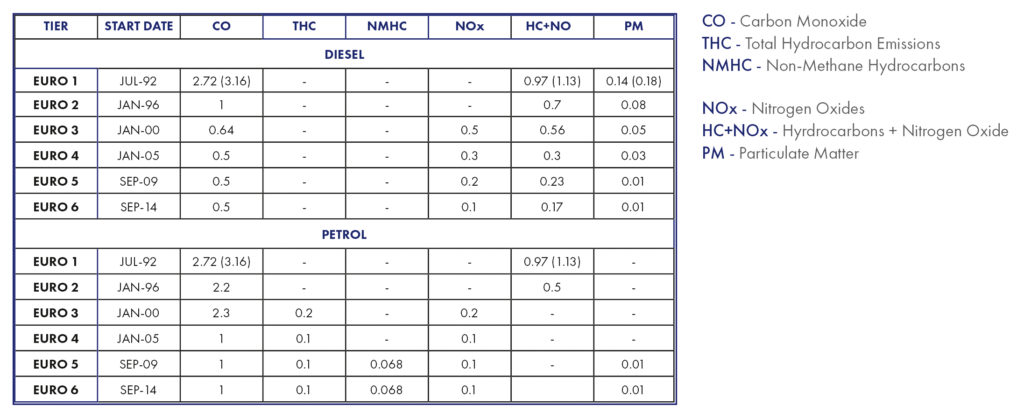7th March 2019
Euro Level Compliance

What are Euro emissions standards?
European legislation for vehicle exhaust emissions has been around since 1970. However it wasn’t until 1992 that emissions standards, or Euro levels, were introduced. Euro 1 applied to all new cars given EU type approval from July 1992 and all new cars first registered from January 1993. This coincided with the compulsory introduction of Catalytic Converters for all new petrol cars in the UK, and since then there has been a gradual tightening of standards for exhaust emissions in the form of new Euro emission standards to help tackle air quality across Europe.
Euro emission standards are, simply speaking, limits for tail pipe emissions from cars and light commercial vehicles (LCVs) with respect to the four main harmful pollutants emitted within exhaust gases. These are nitrogen oxides (NOx), carbon monoxide (CO), particulate matter (PM) and hydrocarbons (HC), all of which are proven to have adverse effects on both health and the environment.
Today, after the introduction of a series of Euro emissions standards over the preceding years, new vehicles must conform to the current Euro 6 standards which came into effect in September 2015. Euro 6 standards are the strictest set to-date. Broadly speaking, Euro 6 significantly reduces the permissible levels of NOx in diesel vehicles and introduces a particulate number limit for petrol vehicles.
New vehicles all have a defined Euro emission standard which can only be achieved if the vehicle has been designed and tested to the levels set out in the legislation. Replacement emission control products, such as Catalytic Converters and DPFs, must be designed to ensure that the vehicle continues to meet legislative limits when independently tested. There is no shortcut to this; if a vehicle is designed to be Euro 4 then the aftermarket Catalytic Converter should also be designed to meet Euro 4 standards when fitted to that vehicle. Certification required for aftermarket parts inextricably ties the part to the vehicles listed on the certificate and to the levels achieved during testing and the appropriate emission standard.
What defines a Euro level?
As the emissions petrol and diesel engines produce are different, the standards they are subjected to are also different as you will see from the table below:

Why are Euro levels important?
Many major towns and cities across the UK and Europe have now introduced, or are considering adopting, Low Emission Zones (LEZ). These ‘clean air’ zones typically involve a charge to enter the area or restrictions on the type of vehicle entering the zone at certain parts of the day. As of today, there are over 200 European cities across 12 countries with restrictions in place based on vehicle emissions.Vehicles considered to be higher polluting are the most likely to be affected by these implementations and this is usually based on the vehicle in questions Euro level. London’s “T-Charge” zone, for example, requires a minimum of Euro 4 for any petrol or diesel vehicle entering the zone between 07:00-18:00, Monday to Friday, with additional fees and penalties in place for any non-complying vehicles.It is important that you know the Euro emissions standard of your vehicle, particularly if you’re planning on driving in London or across Europe. Countries which have already adopted strict Low Emission Zones in major cities include France, Germany, Italy and the Netherlands, all of which have different requirements for entering their clean air zones.In many countries, the Euro level will be listed in the vehicle registration papers but there are also a range of tools available online that can be used to check.
Why it is important to get the correct part?
As it is the vehicle which carries the Euro level, it is a legal requirement to ensure that any replacement emissions control devices are correctly approved for the vehicle and to the correct Euro level of that vehicle. It is not uncommon for the external housing and pipework of parts for different vehicles, approved to different Euro levels, to be the same. This does not mean that the internal specification, the detail of the approval or the performance, will also be the same. This means that even if the part can be made to physically fit to the vehicle, it is crucial to check that the approval covers the vehicle and its respective Euro level.
The Department for Transport released a statement outlining legal requirements in June 2018. The statement confirms that: ‘both suppliers and manufacturers of aftermarket Catalytic Converters have a legal duty to ensure that the products they supply are compliant with the relevant laws and legislation’ and goes on to list examples of non-compliant behaviour, and clarifies that ‘engaging in any of the aforementioned practices can result in a criminal offence, punishable by a substantial fine.’
All manufacturers engaged in the type approval of Catalytic Converters or DPFs must understand their legal obligations and be able to advise customers whether a particular part is correct for a specific vehicle. In addition to this, BM Catalysts are pleased to support the growing moves within the industry to include Euro emission information within all cataloguing data, therefore allowing our customers peace of mind that their part is compliant.
BackPAGES
Stratégies
CONTACT
ADRESSE DE L'ENTREPRISE:
Reed Mill
Sheepbridge Lane
Mansfield
Nottinghamshire
NG18 5DL








